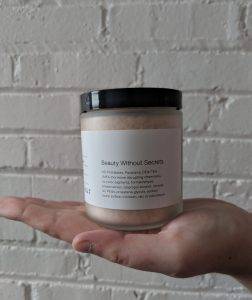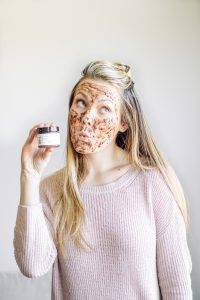Personally, most of my life, I’ve walked into the store and grabbed whatever cheap shampoo I could find. I have always thought, “if it’s on the shelf, can it really be that bad?” The answer is yes, it really can be that bad. As we discussed last week, the research on ingredients Andrea did is the reason OY-L exists today.
Now that I have you thinking about ingredient lists, we are going to look into a few ingredients: parabens, phthalates, butylated hydroxyanisole and fragrance.

OY-L lists out several ingredients we refuse to use, including parabens and phthalates.
Breastcancer.org discusses two groups of chemicals that are being studied for links to breast cancer. The ingredients being studied are parabens and phthalates. Here at OY-L, we do not use either of these. Parabens are often used as a preservative in cosmetic products. According the BreastCancer.org, “Parabens can penetrate the skin and act like a very weak estrogen in the body — potentially turning on the growth of hormone-receptor-positive breast cancers.” The other group of chemicals is phthalates, also in many personal care products. A phthalate is a plasticizer, and is not something you want in your product. These chemicals are hormone disruptors and may disrupt the balance of hormones that interact with estrogen. More information can be found here: http://www.breastcancer.org/risk/factors/cosmetics’
In April, OY-L ran a worldwide survey with over 1000 respondents. Of the 1000 respondents, over half of the respondents didn’t know what parabens and phthalates are, or have never even heard of them.
Next, we are moving on to butylated hydroxyanisole. Have you ever heard of this ingredient? Me neither. However, it can be found in food preservatives as well as lip gloss, makeup, fragrances, and creams. Right now you might be thinking, “Why do I care? An ingredient that is so widely used can’t be that bad.” If only this type of thinking made it true. The National Institute of Health states, “Butylated Hydroxyanisole is reasonably anticipated to be a human carcinogen.” Or in simpler terms, it may cause cancer. Several other health concerns can found here: http://www.safecosmetics.org/get-the-facts/chemicals-of-concern/butylated-compounds/
…and more information here…
https://pubchem.ncbi.nlm.nih.gov/compound/Butylhydroxyanisole#section=Top
Lastly, we are going to talk about a very general term – fragrance. According to the FDA, fragrance ingredients must be just as safe for use as other cosmetic ingredients; however, a company does not need any FDA approval before putting the product on the market. Therefore, a cosmetic company can put whatever ingredients they want under that umbrella. Under United States regulations, any fragrance ingredient may be listed under the term fragrance. The International Fragrance Association lists 3,059 different ingredients that can be used in a fragrance compound. Some of these ingredients have been linked to cancer, reproductive toxicity, and allergies. The FDA states the reasoning for allowing companies to use the singular term fragrance is to keep trade secrets. Basically, the FDA is protecting companies from getting their fragrance copied, but is not protecting you from an allergic reaction or carcinogenic ingredients. You can find more at these two links:
https://www.fda.gov/cosmetics/productsingredients/ingredients/ucm388821.htm
http://www.safecosmetics.org/get-the-facts/chemicals-of-concern/fragrance/
The ingredients I brought up today are just a few of the synthetic ingredients that companies are using and have the potential to be harmful. That being said, just because something is natural doesn’t make it magical either. For example, poison ivy is 100% natural. That wouldn’t exactly be the best ingredient. Making natural products is about choosing the right natural ingredients and combining them in formulas that create an effective, safe product.
Doesn’t this ingredient list make you a lot more comfortable? “Manuka 20+ honey, wild-crafted honey, Abyssinian oil, hemp seed oil, frankincense oil, organic rose petals, organic lavender buds, colloidal oatmeal, rosehip oil, blueberry & cranberry seeds, lavender oil, rosehip extract, willow bark extract.”
By the way, that is our Exfoliating Manuka Mask’s ingredient list. Wouldn’t you be as happy as she is to know you’re using a safe product with zero toxic chemicals? OY-L is “Beauty Without Secrets” because we care about your overall health just as much as we care about your skin. We’re consumers too. I use OY-L products myself and it’s great to know that I can be confident in the efficacy, as well as the safety of the products.

OY-L Exfoliating Manuka Mask
Don’t miss next week’s blog! We will discuss one of the biggest ingredient statements misleading skincare consumers.





